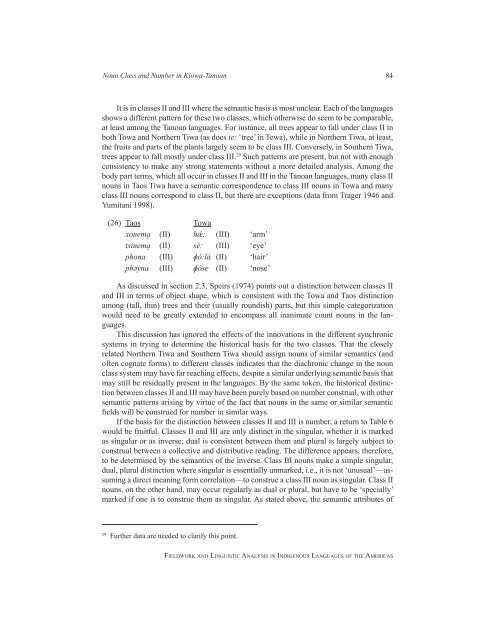Fieldwork and Linguistic Analysis in Indigenous ... - ScholarSpace
Fieldwork and Linguistic Analysis in Indigenous ... - ScholarSpace
Fieldwork and Linguistic Analysis in Indigenous ... - ScholarSpace
Create successful ePaper yourself
Turn your PDF publications into a flip-book with our unique Google optimized e-Paper software.
Noun Class <strong>and</strong> Number <strong>in</strong> Kiowa-Tanoan 84<br />
It is <strong>in</strong> classes II <strong>and</strong> III where the semantic basis is most unclear. Each of the languages<br />
shows a different pattern for these two classes, which otherwise do seem to be comparable,<br />
at least among the Tanoan languages. For <strong>in</strong>stance, all trees appear to fall under class II <strong>in</strong><br />
both Towa <strong>and</strong> Northern Tiwa (as does te: ‘tree’ <strong>in</strong> Tewa), while <strong>in</strong> Northern Tiwa, at least,<br />
the fruits <strong>and</strong> parts of the plants largely seem to be class III. Conversely, <strong>in</strong> Southern Tiwa,<br />
trees appear to fall mostly under class III. 29 Such patterns are present, but not with enough<br />
consistency to make any strong statements without a more detailed analysis. Among the<br />
body part terms, which all occur <strong>in</strong> classes II <strong>and</strong> III <strong>in</strong> the Tanoan languages, many class II<br />
nouns <strong>in</strong> Taos Tiwa have a semantic correspondence to class III nouns <strong>in</strong> Towa <strong>and</strong> many<br />
class III nouns correspond to class II, but there are exceptions (data from Trager 1946 <strong>and</strong><br />
Yumitani 1998).<br />
(26) Taos Towa<br />
xonemą (II) hǽ: (III) ‘arm’<br />
ts<strong>in</strong>emą (II) sé: (III) ‘eye’<br />
phona (III) ɸó:lá (II) ‘hair’<br />
phəyna (III) ɸôse (II) ‘nose’<br />
As discussed <strong>in</strong> section 2.3, Speirs (1974) po<strong>in</strong>ts out a dist<strong>in</strong>ction between classes II<br />
<strong>and</strong> III <strong>in</strong> terms of object shape, which is consistent with the Towa <strong>and</strong> Taos dist<strong>in</strong>ction<br />
among (tall, th<strong>in</strong>) trees <strong>and</strong> their (usually roundish) parts, but this simple categorization<br />
would need to be greatly extended to encompass all <strong>in</strong>animate count nouns <strong>in</strong> the languages.<br />
This discussion has ignored the effects of the <strong>in</strong>novations <strong>in</strong> the different synchronic<br />
systems <strong>in</strong> try<strong>in</strong>g to determ<strong>in</strong>e the historical basis for the two classes. That the closely<br />
related Northern Tiwa <strong>and</strong> Southern Tiwa should assign nouns of similar semantics (<strong>and</strong><br />
often cognate forms) to different classes <strong>in</strong>dicates that the diachronic change <strong>in</strong> the noun<br />
class system may have far reach<strong>in</strong>g effects, despite a similar underly<strong>in</strong>g semantic basis that<br />
may still be residually present <strong>in</strong> the languages. By the same token, the historical dist<strong>in</strong>ction<br />
between classes II <strong>and</strong> III may have been purely based on number construal, with other<br />
semantic patterns aris<strong>in</strong>g by virtue of the fact that nouns <strong>in</strong> the same or similar semantic<br />
fields will be construed for number <strong>in</strong> similar ways.<br />
If the basis for the dist<strong>in</strong>ction between classes II <strong>and</strong> III is number, a return to Table 6<br />
would be fruitful. Classes II <strong>and</strong> III are only dist<strong>in</strong>ct <strong>in</strong> the s<strong>in</strong>gular, whether it is marked<br />
as s<strong>in</strong>gular or as <strong>in</strong>verse; dual is consistent between them <strong>and</strong> plural is largely subject to<br />
construal between a collective <strong>and</strong> distributive read<strong>in</strong>g. The difference appears, therefore,<br />
to be determ<strong>in</strong>ed by the semantics of the <strong>in</strong>verse. Class III nouns make a simple s<strong>in</strong>gular,<br />
dual, plural dist<strong>in</strong>ction where s<strong>in</strong>gular is essentially unmarked, i.e., it is not ‘unusual’—assum<strong>in</strong>g<br />
a direct mean<strong>in</strong>g form correlation—to construe a class III noun as s<strong>in</strong>gular. Class II<br />
nouns, on the other h<strong>and</strong>, may occur regularly as dual or plural, but have to be ‘specially’<br />
marked if one is to construe them as s<strong>in</strong>gular. As stated above, the semantic attributes of<br />
29 Further data are needed to clarify this po<strong>in</strong>t.<br />
fieldwork <strong>and</strong> l<strong>in</strong>guistic analysis <strong>in</strong> <strong>in</strong>digenous languages of the americas

















